Abstract
This paper discusses a topic titled “The Potential of Social Networks for Educational Purposes of Different Age Groups”. Nowadays, the concept of connectivism becomes more and more prevalent not only in Czech schools and is manifested, for example, by an increasing use of social networks in education. We have decided to respond to this circumstance by conducting research survey to reflect the use of this type of new media in education. Canadian researcher, Siemens (2005), was the first to introduce the concept of connectivism as early as in 2005 which was followed up by Downes in 2012. Connectivism perceives learning mainly as a process that in its essence is focused on connecting various information sources and people who share knowledge and communicate via social networks in real time. This paper presents research questions, purpose of the study, methodology used in the research survey, and its results. The main goal of the research was to ascertain the potential of social networks during home preparation with respect to different age groups. We have focused on the following age groups: Grade 8 of primary school = 14 years of age - lower secondary education, grade 3 of secondary school = 18 years of age (higher secondary education), third (junior) year -university students studying the Foundations of Technical Sciences and Information Technology in Education = 22 years of age. While conducting the research survey, we focused on several social networks (Facebook, Twitter, Instagram, etc.) in order to be able to examine the issue in the broadest possible context. The methodology used comprises mainly quantitative methods used in educational research of a descriptive and relational nature. Data was collected through a questionnaire and evaluated using relevant statistical methods.
Keywords: Connectivismsocial networkFacebookhome preparation
Introduction
The period since the 1960s is referred to as that of the post-industrial society, where information is more important than production. Nowadays, we talk about the so-called “information society”. J. Zlatuška (1998) defined information society as follows:
These facts have induced considerations related to a greater level of utilisation of modern ICT resources in education. One of the outcomes of these considerations is the concept of connectivism, which, according to its founder George Siemens, is referred to as the “
In the following subsection, we will introduce the tools and activities derived from the theory of connectivism in detail.
Connectivism
In the virtual environment, some specific processes and tools that are closely linked to modern information and communication technologies are utilised to structure knowledge (Tracey, 2009):
discussion fora – asking questions, clarifying context, sharing knowledge,
wiki models and non-linear knowledge banks – social construction of knowledge,
search functions – independent organisation of further research.
A higher level of knowledge and skills is represented by tools and activities derived from the theory of connectivism, which introduce the necessity to connect to relevant information sources within the current exponential growth of the information volume. Therefore, connectivist activities include, in particular (Tracey, 2009):
external news channels (RSS), blogs, wiki modules, and discussion fora,
information directories, external link databases,
social and professional networks – Facebook, Twitter, etc.
As is apparent from the above overview, social networks are one of the tools used by connectivism. Mezrich (2010) characterises the term “online social network” as “
Home Preparation
Home preparation is often characterised as an extra-curricular activity that is, however, closely related to schooling, which it complements. All pupil activities, which are required by the school and which purposefully aim at supporting school classes, can be regarded as home preparation.
The following activities relate to the term home preparation:
Written revision and practise of the studied curriculum,
oral revision and practise of the studied curriculum,
collection of information and materials and acquisition of information from extra-curricular resources,
searching for information and processing new findings.
Social networks utilised for home preparation can serve as:
A tool for communication and tutoring between a teacher and a pupil,
a tool of communication and tutoring among pupils,
a tool of communication between a teacher/school and parents.
Problem Statement
Social networks constitute a phenomenon of the last few years. The young generation can no longer imagine life without social networks. Social networks are not just about status updates and photo sharing - they also feed into the popularisation of science, advertising, and human resource management. The question arises whether social networks can also be useful in education, politics, culture, etc. Therefore, the main reason for conducting this research survey was to find an option of meaningful utilisation of these networks, as a contemporary undeniable phenomenon, in education. The research survey’s goal is to analyse the views of pupils and students on social networks as a new medium where they can educate themselves, and a medium they can use as an aid for home preparation.
Research Questions
In the questionnaire survey, we asked the following questions, where a pupil or student could only select one response to each question:
Do you usually find important information on social networking sites (Facebook, Instagram, Twitter, and others) through messages, photos, by correspondence?
Would you welcome communication with your teacher via a social network (Facebook, Instagram, Twitter, and others)?
While doing homework or preparing for a written or oral exam, do you use social networks (Facebook, Instagram, Twitter, and others) for communication with classmates?
Do you think that communication via social networks (Facebook, Instagram, Twitter, and others) allows for faster and more convenient communication with pupils from partner schools (Czech and foreign) with whom we meet, for example, during exchange programmes or projects (e.g. eTwinning)?
Is searching for information within a social network (Facebook, Instagram, Twitter, and others) faster for you than searching for information in printed textbooks?
Do you make use of communication via a social network (Facebook, Instagram, Twitter, and others) more often than conventional calling over the phone or texting?
Purpose of the Study
The research survey was conducted in order to find out what the potential of social networks is in home preparation of pupils and students. The purpose was to find out whether there are differences in the use of social networks depending on age. Based on the aforementioned aims, we have conducted research survey, which focused on the context of the impact of learning with tools and processes that pupils and students use during learning with the support of social networks. In the following chapter, we will describe the methodology used in the research survey in detail.
Research Methods
The necessary research data was collected via a questionnaire survey. The respondents involved in the research were selected using a simple deliberate sampling method. The research was conducted within the Czech Republic. The resulting sample consisted of 188 pupils and students, namely 77 pupils (grade 8 of primary school), 78 pupils (grade 3 of the secondary school), and 33 second (sophomore) and third (junior) year university students studying Technical and Information Education.
The results were evaluated using category-rating scale. F. N. Kerlinger defined “scale” as follows: “A scale is a set of symbols or numerals so constructed that the symbols or numerals can be assigned by rule to individuals (or their behavioural acts) to whom the scale is applied” (Kerlinger, 1972). In category rating scale, the respondent is given several ordered categories, from which they are to select the one that best describes the observed fact. In our case, responses were selected as follows: always, often, less often, not at all.
The specific results will be presented in the next chapter.
Findings
Question 1: Does a pupil or student find important information on social networking sites (Facebook, Instagram, Twitter, and others) through messages, photos, by correspondence?
It is apparent from Graph
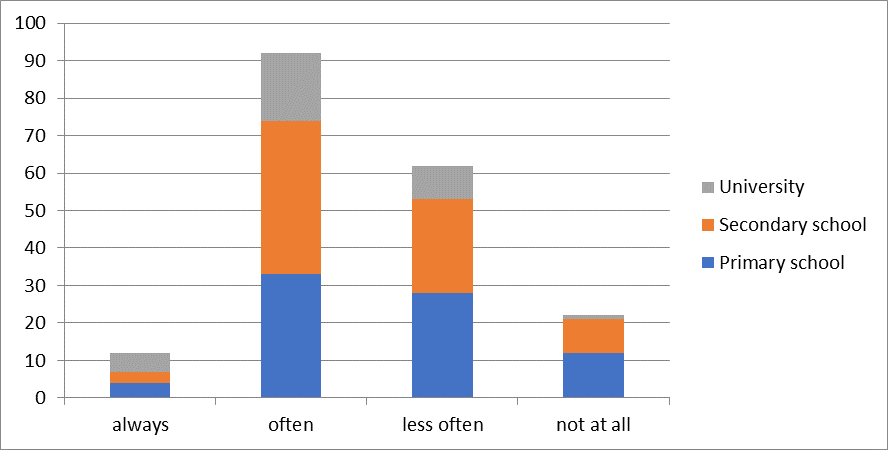
Question 2: Would the pupil or student welcome communication with their teacher via a social network (Facebook, Instagram, Twitter, and others).
The responses to Question 2 show that primary and secondary school pupils cannot imagine communication with their teacher via social networks. This could be due to several reasons: the pupils are afraid that the personal contact between the teacher and pupil would disappear, writing takes up more time, such communication could lead to a misunderstanding on both sides, communication via social networks can decrease teacher authority. 51.5% of university students can imagine such communication.
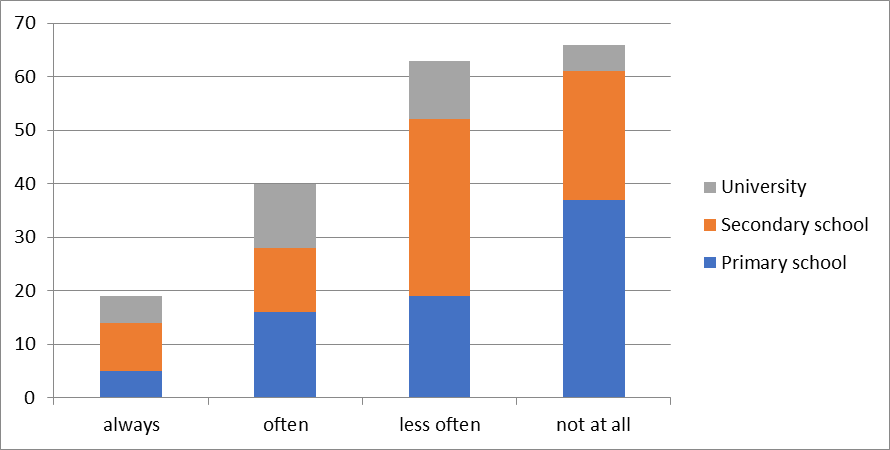
Question 3: When doing homework or preparing for a written or oral exam, does a pupil or student use social networks (Facebook, Instagram, Twitter, and others) for communication with classmates?
65% of secondary school pupils and 76% of university students discuss home preparation on social networks. In contrast, this figure is only 44% for primary school pupils.
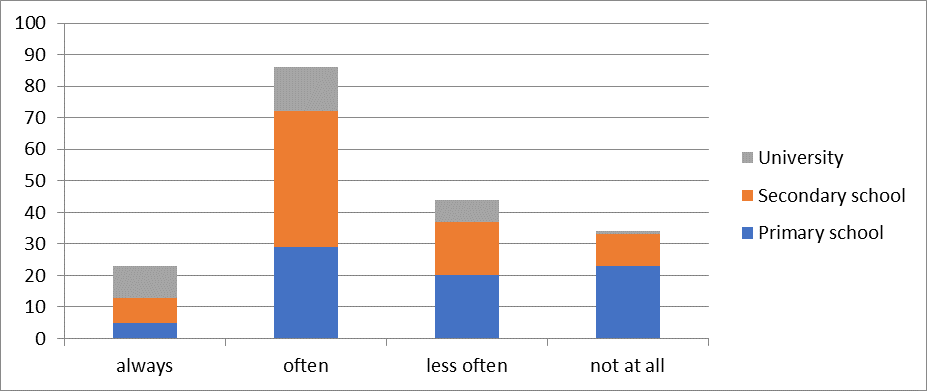
Question 4: Does a pupil or student think that communication via social networks (Facebook, Instagram, Twitter, and others) allows for faster and more convenient communication with pupils from partner schools (Czech and foreign) with whom they meet, for example, during exchange programmes or projects (e.g. eTwinning)?
As can be seen from Table
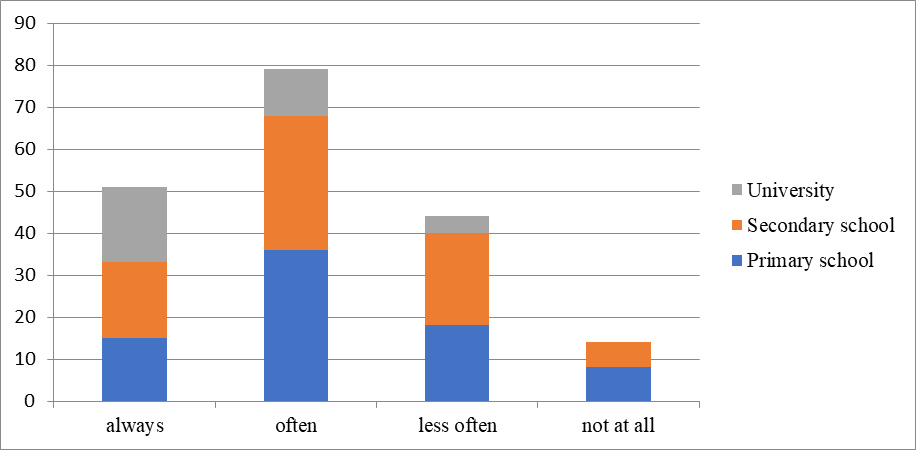
Question 5: Is searching for information within a social network (Facebook, Instagram, Twitter, and others) faster for a pupil or student than searching for information in printed textbooks?
58.5% of primary school pupils find searching for information on social networks to be faster than searching for information in printed textbooks. For secondary school pupils, this share is higher - 64%. 70% of university students search for information faster on social networks than in textbooks (university textbooks), which is the highest share of all three age groups.
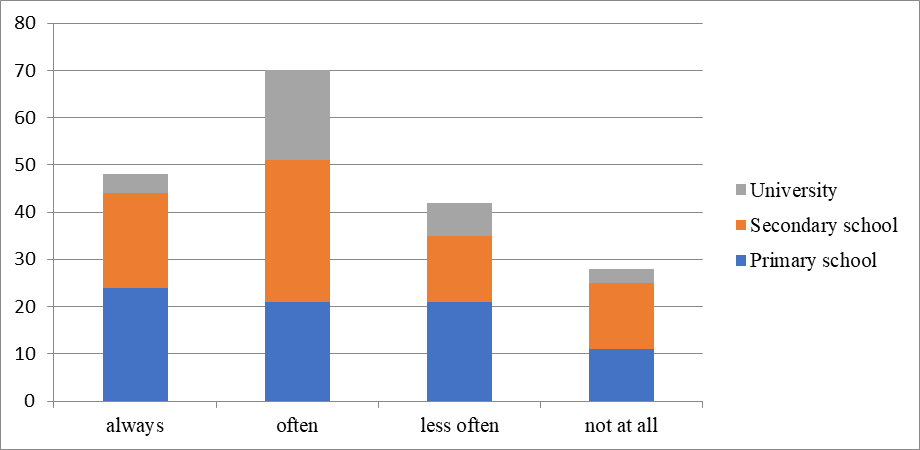
Question 6: Does a pupil or student make use of communication via a social network (Facebook, Instagram, Twitter, and others) more often than conventional calling over the phone or texting?
In Question 6, all age groups prefer to communicate via social networks rather than make use of conventional calling or texting over the phone. This could be due to the fact that communication via social networks is free of charge and the majority of pupils and students has an account on one of the social networks.
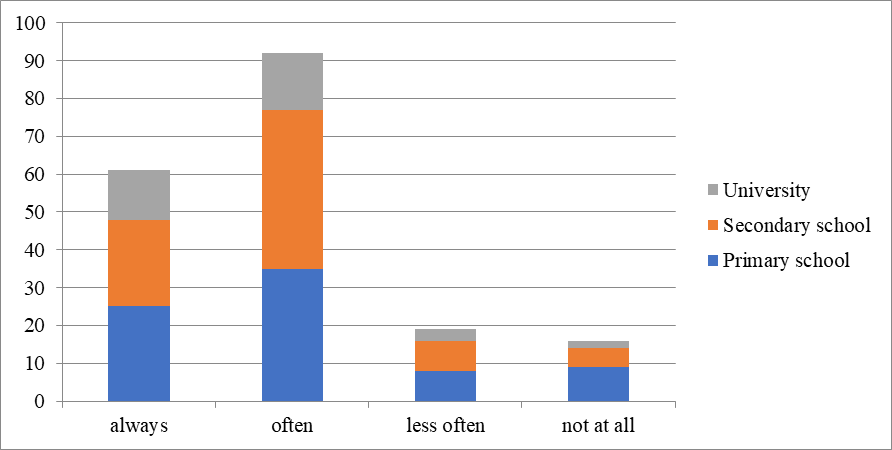
Conclusion
The paper discussed the potential of social networks for educational purposes in different age groups. We have focused on the following age groups: Grade 8 = 14 years of age - lower secondary education, 3rd year = 18 years of age (higher secondary education), 3rd year (junior) university students studying the Foundations of Technical Sciences and Information Technology in Education = 22 years of age. The use of social networks in education is a part of the theory of connectivism, which takes into account the changing needs of contemporary society and methods of teaching students. We have focused on Facebook, which is the most widespread social network in our socio-cultural conditions, and further on Twitter and Instagram. It is important to utilise the potential of social networks in education, in particular at higher secondary schools and universities. The research survey has provided us with other valuable incentives to develop scientific work in this area, and has identified other problem areas where further research is possible.
Acknowledgments
This paper was completed with the support of a project of the Grant Fund of the Dean of the Faculty of Education, Palacky University in Olomouc titled “Research into the Options of the Use of Social Networks in Education, Depending on the Degree of Intentionality to Learn, in Different Age Groups”, which was implemented in 2017.
References
- Brdička, B. (2008). “Konektivismus – teorie vzdělávání v prostředí sociálních sítí” (Connectivism - Theory of Education on Social Networking Sites), Učitelský spomocník (Teacher’s Aid)
- [online]. Available at: http://www.spomocnik.cz/pub/Konektivismus_BB08.pdf.
- Portal, ,( ). AnIntroduction to Connective Knowledge. In: Stephen’s Web [online]. Available at: http://www.downes.ca/post=33034.
- Portal, ,( ). Creatingthe Connectivist Course. In: Stephen’s Web [online]. Available at: http://www.downes.ca/post/57750.
- Mezrich, B., (2010). The Accidental Billionaires. The Founding of Facebook, A Tale of Sex, Money, Genius, and Betrayal. ISBN 978-80-251-2823-7.
- Kerlinger, F. N., (1972). Foundations of Behavioural Research. Praha: Academia.
- Palfrey, J., & Glasser, U. (2008). Born Digital: Understanding the First Generation of Digital Natives. Oxford, Oxford Press.
- Ouředníček, M. (2001). Digital Natives, Digital Immigrants [online]. On the Horizon 9(5). Available at: http://www.marcprensky.com/writing/Prensky%20%20Digital%20Natives,%20Digital%20Immigrants%20-%20Part1.pdf.
- Siemens, G., (2004). Connectivism: a Learning Theory for the Digital Age. In: Elearnspace: everything elearning[ online]. Available at: http://www.elearnspace.org/Articles/connectivism.htm.
- Siemens, G., (2006). Connectivism: Learning Theory or Pastime for the Self-Amused? Available at: http://www.elearnspace.org/Articles/connectivism_self-amused.htm.
- Tracey, R., (2009). Instructivism, constructivismorconnectivism?. Training and Development in Australia. 36(6), s. 8-9. ISSN 0310-4664.
- Veen, W., Vrakking, B. (2006). Homo Zappiens. Growing Up In A Digital Age. London, Network Continnum Education.
Copyright information

This work is licensed under a Creative Commons Attribution-NonCommercial-NoDerivatives 4.0 International License.
About this article
Publication Date
16 October 2017
Article Doi
eBook ISBN
978-1-80296-030-3
Publisher
Future Academy
Volume
31
Print ISBN (optional)
-
Edition Number
1st Edition
Pages
1-1026
Subjects
Education, educational psychology, counselling psychology
Cite this article as:
Budinova, V. (2017). The Potential Of Social Networks For Educational Purposes Of Different Age Groups. In Z. Bekirogullari, M. Y. Minas, & R. X. Thambusamy (Eds.), ICEEPSY 2017: Education and Educational Psychology, vol 31. European Proceedings of Social and Behavioural Sciences (pp. 589-598). Future Academy. https://doi.org/10.15405/epsbs.2017.10.56

